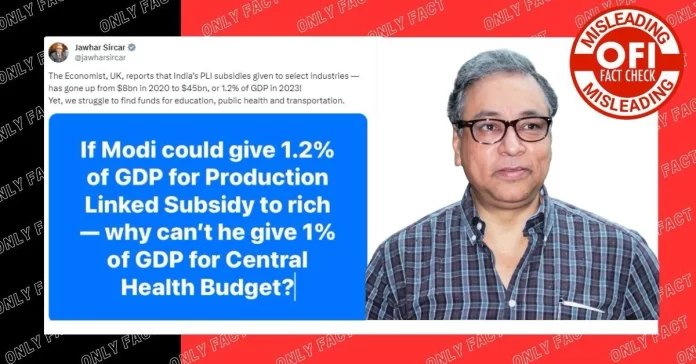Jawhar Sircar, a Rajya Sabha member representing the Trinamool Congress, recently shared a post on an X, earlier Twitter, asserting that the Indian government, through the Production Linked Incentive scheme, is providing a subsidy equivalent to 1.2 percent of the country’s GDP to the affluent segments of society. He questioned why a similar financial commitment couldn’t be directed towards augmenting the Central Health Budget by 1 percent of the GDP. Sircar, has gained notoriety for disseminating misinformation and offering seemingly irrational critiques of Prime Minister Narendra Modi.
Jawahar Sircar wrote,” The Economist, UK, reports that India’s PLI subsidies given to select industries — has gone up from $8bn in 2020 to $45bn, or 1.2% of GDP in 2023! Yet, we struggle to find funds for education, public health and transportation.”
The Economist, UK, reports that India’s PLI subsidies given to select industries — has gone up from $8bn in 2020 to $45bn, or 1.2% of GDP in 2023!
— Jawhar Sircar (@jawharsircar) January 4, 2024
Yet, we struggle to find funds for education, public health and transportation. pic.twitter.com/cW90mAq0CW
Before delving deeper into our discussion, let us take a moment to elucidate the intricacies of the Production Linked Incentive (PLI) scheme. The Production Linked Incentive (PLI) scheme by the Indian government is a type of incentive tied to a company’s performance, particularly on increased sales of products made within the country. Its main goals are to boost the manufacturing sector, decrease reliance on imports, and align with the Make in India initiative.
The scheme aims to encourage foreign companies to initiate production in India and domestic manufacturers to expand their production and exports. Currently, the PLI scheme applies to 14 sectors, including telecommunications, white goods, textiles, medical devices, automobiles, speciality steel, food products, high-efficiency solar PV modules, advanced chemistry cell batteries, drones, and pharmaceuticals.
Having discussed comprehensively into the nuances of the Production Linked Incentive (PLI) scheme, it becomes evident that its primary objective is to fortify India’s domestic growth and enhance employment rates. The substantial 7 percent GDP growth stands as a testament to the efficacy of the PLI scheme, which appears to be operating at peak efficiency. Nevertheless, our focus in this article will pivot towards fact-checking the assertion that India allocates less than 1 percent of its GDP to healthcare.
Fact Check
Within the Indian Constitution, the health sector is situated under the seventh schedule, a framework that encompasses three distinct categories: the Union list, the state list, and the concurrent list. This delineation underscores the fact that health is a subject falling within the jurisdiction of individual states. Despite this decentralized approach, when considering expansive elements such as the development of health infrastructure, including institutions like AIIMS and National Health Mission, the central government plays a pivotal role by allocating budgets to the health sector. Therefore, the assessment of health expenditure in India is a comprehensive calculation that incorporates both state and central expenditures.
Last year, a report was published by the Press Information Bureau, “Central and State Governments’ budgeted expenditure on the health sector reached 2.1 per cent of GDP in FY23 (BE) and 2.2 per cent in FY22 (RE), against 1.6 per cent in FY21.”


Another report published by PIB said, “Current Health Expenditure (CHE) is Rs.5,40,246 crore (90.6 per cent of THE) and capital expenditures is Rs.56,194 crore (9.4 per cent of THE). Of the Government Health Expenditure (GHE), Union Government’s share is 34.3 per cent and the State Governments’ share is 65.7 per cent.”

The Economic Survey report from the preceding year mirrors a consistent pattern. According to the Live Mint report, the combined budgeted healthcare expenditure by both the central and state governments reached 2.1% of the GDP in the fiscal year 2022-23 and 2.2% in the fiscal year 2021-22, marking a notable increase from the 1.6% recorded in the fiscal year 2020-21. These findings were presented in Parliament by Finance Minister Nirmala Sitharaman as part of the Economic Survey 2022-23.
In summary, the claim made by Rajya Sabha member Jawhar Sircar of the Trinamool Congress is misleading. While the health sector in India is indeed under the purview of individual states, it is crucial to acknowledge the central government’s significant contributions to both infrastructure development and the National Health Mission. Consequently, the comprehensive calculation of health expenditure encompasses the collective financial commitment of both the state and central governments, which stood at 2.1 percent of the GDP in the last fiscal year.
| Claim | Central Government doesn’t spend even 1 percent of the GDP on Health |
| Claimed by | Jawahar Sircar |
| Fact Check | Misleading |
Also Read: Viral Video of Collective Toilets Not Related to Ayodhya’s Ram Mandir Pran Pratistha Program









